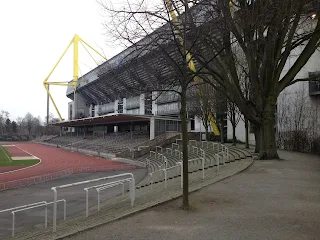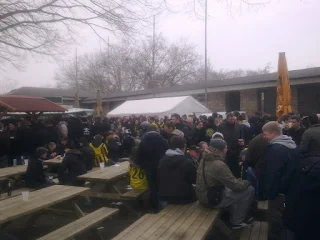Borussia Dortmund II is the reserve side of B.V. Borussia 09 e.V Dortmund. The league system in Germany allows reserve teams to play in their leagues. When the team was set up, it initially played in the local Kreisliga. In 1957, they were promoted to the Bezirksliga.
By 1964, they had progressed to the Landesliga Westfalen. Five years later, the side walked away with that title to go up to the Oberliga Westfalen, which was the third level of German football at the time. In 1974, the new Westfalenstadion was built, leaving Borussia Dortmund II to use the old Stadion Rote Erde.
Borussia Dortmund II reached the final of the Westphalia Cup in 1991, where they were defeated by Arminia Bielefeld. However, the team qualified for the following season's DFB-Pokal (German Cup). They went out 5-2 in the first round against 1. FC Saarbrücken, in the tie played at Stadion Rote Erde.
In 1998, coach Michael Skibbe led the team to a convincing Oberliga Westfalen title with promotion to Regionalliga West/Südwest. Dortmund should have been relegated at the end of their first season, but they were reprieved as both Wuppertaler SV and FC 08 Homburg failed to meet their financial obligations.
For the 2000-01 campaign, Dortmund were shifted to the Regionalliga Nord under Edwin Boekamp. The team were relegated after one season back to Oberliga Westfalen, where they won promotion again at the first attempt with Horst Koppel at the helm.
In 2004-05, the team suffered another demotion, but again showed great tenacity by going straight back up. In 2008, Dortmund were placed in Regionalliga West. Theo Schneider took his team to the title in 2008-09, winning promotion to the recently formed 3. Liga, where they lasted for just one campaign.
This was by way of the goals of Hamadi Al Ghaddioui and Michael Eberwein before Farke moved to Norwich City to be replaced by Jan Siewert. His side ended in fourth in 2017-18 and then fifth twelve months later, with Joseph Boyamba top scoring. Alen Terzic and then Mike Tullberg took charge of the team for 2019-20
Borussia were in seventh spot when the COVID-19 pandemic called a halt to proceedings before the appointment of trainer Enrico Maaßen in July 2020, who took the side to the Regionalliga title with Steffen Tigges leading the scoring, before the team consolidated their position in 3. Liga the following season.
Christian Preußer was put in charge of the team in June 2022, lasting until the following February, when he was replaced by Jan Zimmermann in a season in which Justin Njinmah stood out before Ole Pohlmann top-scored in 2023-24. The side went back down to the Regionalliga as Mike Tullberg was given the trainer's job in May 2025.
Borussia Dortmund II will play in Regionalliga West in the 2025-26 season.
My visits
Saturday 23rd January 2010 and Saturday 19th February 2011
Dortmund was the destination for a couple of lads’ football weekends. First up, it was with Crusher, Carl and Colm for the Bundesliga clash with Hamburger SV. On the second occasion, Crusher couldn’t make it, leaving just the three of us. We attended the FC St Pauli top-flight game.
The Hamburg game was a tea time kick off, so I couldn't get a great look, but I went inside for a beer from one of the many stalls vending from the gates to Stadion Rote Erde. The St Pauli clash was an afternoon game, so it was easier to get a proper impression.
Stadion Rote Erde really was a decent arena, but it was easy to see why BVB wanted to go more modern and opt for a stadium without a running track when they set a trend that took a lot longer to catch on around Germany when they built the Westfalenstadion for the 1974 World Cup.
The old place was still in decent condition, even though the DFB had to give it special dispensation to hold 3. Liga football.
The Main Stand was a single tier of bench seating with many pillars holding up the roof, which was dwarfed by the new, enlarged stadium next door. The rest of the stadium consisted of decent open terracing around the 400m running track.
The steps went even further back behind the ends. Behind the far curve, the terrace was interrupted with a fine old arched entrance.
Sunday 28th February 2016
I was back once again for the Borussia v Hoffenheim clash next door. Having alighted at the DB stadium station, I made my way up around Stadion Rote Erde to the entrance, where once again beer and food were available inside.
This was an ideal opportunity to update my photos and enjoy refreshments before heading next door to watch the match.
I was back once again for the Borussia v Hoffenheim clash next door. Having alighted at the DB stadium station, I made my way up around Stadion Rote Erde to the entrance, where once again beer and food were available inside.
This was an ideal opportunity to update my photos and enjoy refreshments before heading next door to watch the match.









No comments:
Post a Comment